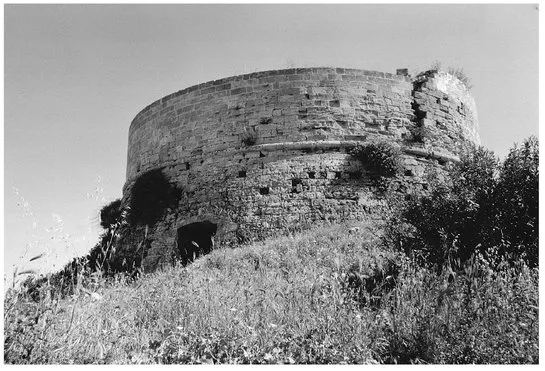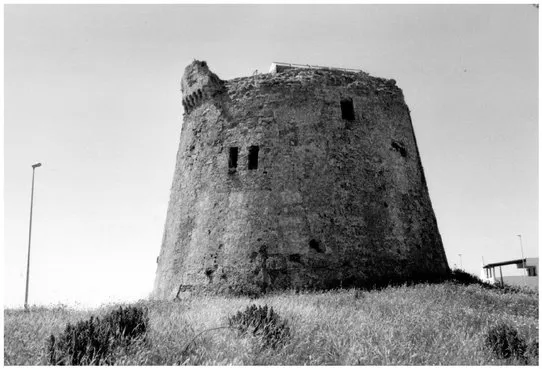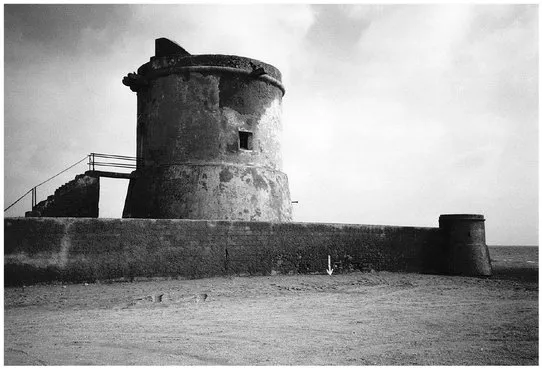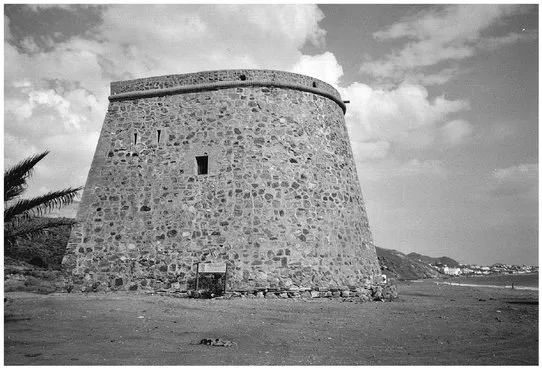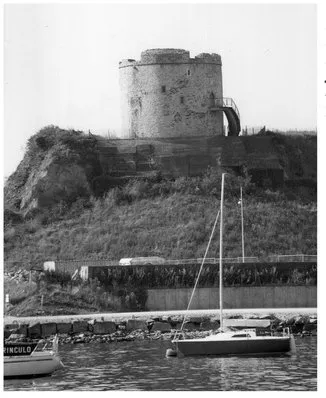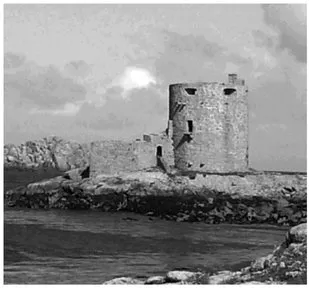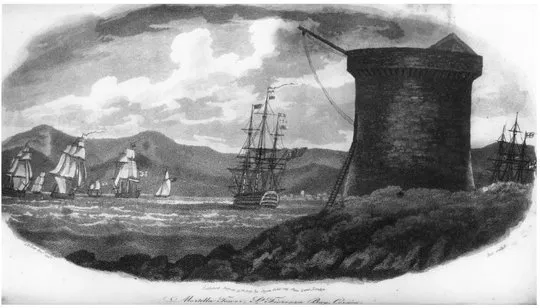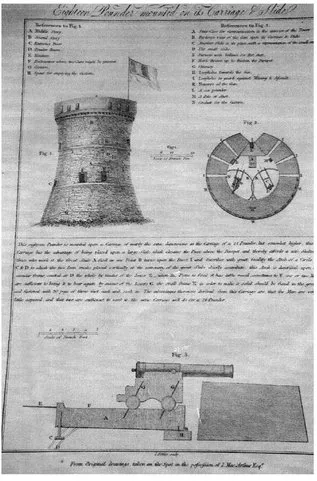![]()
Chapter 1
The Background to the Towers
The British Martello towers and blockhouses of the late eighteenth and nineteenth centuries were defensive structures built to defend the coasts of England and its colonies from French invasion. As such they were simply later examples of an earlier tradition of defensive towers constructed along the European coastline, but particularly around the shores of the Mediterranean, from the fifteenth century onwards.
As a form of fortification the single, unsupported gun tower was a cheap and effective form of coast defence providing early warning of attack and proving, particularly in the case of the larger towers, to be difficult to capture and destroy. The earliest towers built along the shores of the Mediterranean were watchtowers the role of which was to enable their garrisons to warn the local inhabitants of approaching Turkish raiders or North African corsairs. However, as the concept of defensive towers was developed by the military engineers of the time so larger and more substantial towers were built that were strong enough to mount two or three guns. These later towers were usually sited to defend small ports or fishing villages or to protect the entrances to larger ports.
The Mediterranean
It is difficult to put a date to the construction of the earliest towers in the Mediterranean, but as early as the thirteenth century towers had been built in southern Spain along both the inland and the coastal borders of the Moorish Nazrid kingdom of Granada. These were conical watchtowers built between 1238 and 1492 of rubble stone and were designed to give warning of Christian forces. These towers were normally manned by one or two watchmen and had very limited defensive value. After the fall of the Nazrid kingdom to the forces of Ferdinand and Isabella in 1492 the coastal towers were maintained to give warning of raids by Moorish forces and a number of larger towers were built capable of mounting one or two guns.
In the latter half of the sixteenth century the Spanish occupied most of southern Italy and Sicily together with Sardinia and by allying themselves with the Republic of Genoa brought Corsica also under Spanish influence. As Turkish attacks on the Italian coast increased the Spanish governors-general in Italy commenced the construction of a long line of coastal towers from Bari on the Adriatic shore to Taranto and up the Calabrian coast on the western side of Italy. These towers were also built of stone and varied in size and design, some being square and others circular in shape.
Torre Vecchia degli Uomini morti, near Leuca in the commune of Lecce in Puglia.This tower was built in 1576 and was originally armed with a 2 pdr bronze falconet and then re-armed with a 3 pdr gun. The tower was rebuilt in 1696. (Author’s photograph)
The designers of these towers were a small group of Italian and Spanish military engineers working for the Kings of Spain and the Spanish governors-general in Italy, Sicily and Sardinia. They also worked for the Banco di San Giorgio, a commercial organization that administered the colonies of the Republic of Genoa in much the same way as, two centuries later, the Honourable East India Company administered British India. In the sixteenth century engineers such as Palearo Fratino (c1520–1586), the chief military engineer to the court of Castile and one of a family of three famous military engineers, Camillo Camiliani (1574–1603) and Juan Baptista Antonelli (1550–1616) all designed and built towers and other fortifications along the coasts of Granada, Corsica and Sicily. In Corsica 85 towers were built around the coast of the island, including a tower at Mortella Bay on the north-west side of the island that was designed by Fratino while a very similar tower, the Torre di San Cosmano, designed by Camillo Camiliani, was built near Augusta in Sicily. Many of the towers built for the Banco di San Giorgio were to become known as ‘Genoese Towers’ and were to be found throughout the Mediterranean and as far afield as Balaklava in the Crimea where there was a Genoese settlement.
In the latter half of the sixteenth century a long line of coastal towers was constructed along the southern shores of Italy. These were defensive towers and they were part of a chain of fortifications protecting the coastline from Bari to Taranto. Between 1565 and 1620 a total of 81 towers were built along the coasts of the provinces of Bari, Lecce and Taranto with additional towers northwards along the Calabrian coast almost as far as Rome. There was no standard pattern for these towers, the majority being square in shape and the others, some 19 in all, were circular. All were built of stone and, as with the Genoese towers, the entrance was through a door at first-floor level entered by means of a ladder or drawbridge. Ten of these towers were built in the province of Bari, 57 in the province of Lecce and 14 in the province of Taranto. All the circular towers are to be found in the province of Lecce.
Torre Fiumicelli o Mozza, near Ugento in the commune of Lecce in Puglia. Constructed in 1584 the tower had a machicolation built on the rear of the parapet as can be seen in the picture. (Author’s photograph)
The majority of these towers were armed with a single falconet. A small gun firing a ball between one and three pounds in weight. However, two towers, the Torre S. Caterina and the Torre Squillace north of Gallipoli were described as being armed with ‘large bronze guns mounted on wheels and bed of iron’.1 Another tower, the Torre S. Leonardo near Ostuni, was armed with a 5 pdr gun because the tower would not support the 6 pdr originally intended for it.2 Amongst the architects of these towers was Giovanni Tommaso Scala who visited England in 1545 and advised Sir Richard Lee on Tynemouth Castle, and Giovanni Vincenzo Spalletta. In all a total of 313 towers were built along the coastline of the Kingdom of Naples by the viceroy Pietro de Toledo while around the coast of Sicily the viceroy, Ferrante Gonzaga, built a further 137 towers.
Torre de San Miguel de Cabo de Gata was designed by the Spanish engineer Thomas Warluzel d’Hostel in 1756. It is similar to the tower at Balerma and was armed with two small guns. The entrance was at first-floor level and was approached across a small drawbridge. (Author’s photograph)
In Spain itself towers were to be found all along the coastline of the Mediterranean from Barcelona to Tarifa. Although many of these towers were of Moorish design and construction the towers mounting guns were of indigenous Spanish design and of a later date, most having been built during the mid-eighteenth century. It was during the reigns of Ferdinand VI and Charles III between 1746 and 1788 that major efforts were made to protect the coastal regions by constructing gun towers and batteries. Under Ferdinand VI a number of gun towers were constructed, circular in shape and mounting one or two small guns. Such towers can be seen at Cabo de Gata and Balerma in Almeria which each mounted one 8 pdr and one 6 pdr gun though they were subsequently strengthened to take two 24 pdr guns. Other towers, rather larger and with a batter to the wall, can be seen at Cabo Jueu on Ibiza, Gando on Gran Canaria and at Alcufar on the island of Menorca and at other places along the coast of mainland Spain. These towers were designed to mount two heavy guns, usually 24 pdr guns.
The improvement in the defences of the Kingdom of Granada continued in the reign of Charles III and in 1764, as a result of the depredations of the British in the Seven Years War in which Spain was involved from 1762 to 1763, Charles III issued an ‘Ordinance that His Majesty sends as Orders to those who serve in the different ranks destined for Royal Service in the coast of the Kingdom of Granada’. This long-winded title authorized Field Marshal Antonio Maria Bucarelli y Ursua to plan and construct a series of fortifications along the coasts of the modern Spanish provinces of Granada, Malaga and Almeria. Under this ordinance a total of nine new four-gun batteries were built together with a number of two-gun towers. These towers were designed by the Spanish military engineer Jose Crame and were considerably larger than those built in the reign of Ferdinand VI and were in the shape of a ‘cloven-hoof’ and not circular. This meant that there was a stronger and larger gun platform to support the two heavy guns.
Castillo de Macenas, Mojacar, Spain. This tower was built in 1765 on the order of Charles III. It was built to the ‘cloven hoof ’ design of Jose Crame and mounted two heavy guns. (Author’s photograph)
Early British Gun Towers
The use of gun towers as a defensive fortification was not confined to the shores and islands of the Mediterranean. In England the earliest example of a free-standing gun tower still remaining is, probably, the Cow Tower in Norwich, part of the fortifications of that city. Other early towers are the Round Tower at Portsmouth, built in 1418, and the tower of Camber Castle in Sussex which, originally, was a free-standing artillery tower built to defend the harbour of Camber. Across the Solent, on the Isle of Wight, Worsley’s Round Tower was built on Sharpnode Point between 1522 and 1525 to command the channel between Hurst Point and the Isle of Wight, though this was probably more of a single-storey blockhouse than a tower.
The Mount Batten Tower was built around 1650 to defend the headland overlooking the Cattewater and Sutton Harbour. It was armed with ten small guns and was still armed in 1716 but subsequently fell into disuse. (Author’s photograph)
In the seventeenth century two gun towers were built for coastal defence, one at Plymouth, the Mount Batten Tower, and the other, Cromwell’s Castle, on Tresco in the Scilly Isles. Both these towers were built during the Commonwealth, probably as a defence against the Dutch. Although the actual date of its construction is uncertain the Mount Batten Tower was probably built as early as 1646 and it is a circular masonry tower 30 feet (9.2 metres) high with a castellated parapet and embrasures for 10 guns. The tower has two floors and a basement and access is at first-floor level. There is a staircase built into the wall providing access to the second floor and the gun platform.
The tower on Tresco in the Scilly Isles, Cromwell’s Castle, was probably built about 1650–52 to defend the harbour of New Grimsby from the Dutch. This too was a circular masonry tower, but, with a height of 48 feet (15 metres), it was much taller than the Mount Batten Tower. Cromwell’s Tower, like the Mount Batten Tower, has two floors providing barrack accommodation together with a basement and the original entrance at first-floor level. There are embrasures for six guns on top of the tower and the parapet, unlike the Mount Batten Tower, was not castellated. In the eighteenth century the guns mounted on the gun platform were small 4 pdr guns.
Cromwell’s Castle on Tresco in the Isles of Scilly was constructed between 1650 and 1652 to defend the harbour of New Grimsby. On the gun platform on top of the tower there were embrasures for six guns. (Author’s photograph)
A number of gun towers were also constructed by the British authorities for the defence of Bermuda and the British islands in the West Indies. In 1745 a tower was built by the Codrington family on Barbuda to defend their plantation on the island. The tower and an adjacent battery were built to a plan provided by Commodore Charles Knowles RN, who was then commanding the Royal Navy Leeward Islands station, and was known as River Fort. The Codrington papers refer to a proposal to build a tower ‘like the Spanish coastal towers’ and Knowles’s design was almost exactly that. On Tortuga in the British Virgin Islands a tower named Fort Recovery was built during the War of American Independence as part of the defences of the island. Not as high as some of the Spanish towers, it nevertheless bears many similarities to such towers.
The Incident at Mortella Bay
In 1794 elements of the British Mediterranean fleet which was blockading Corsica attacked one of the Genoese towers at Mortella Point in the Bay of San Fiorenzo in the north of the island. Admiral Lord Howe, always opposed to a purely passive blockade, had decided upon offensive action to destroy the tower and dispatched a landing force under the command of Major General Dundas to Mortella Bay. Two Royal Navy ships, HMS Fortitude (74 guns) and HMS Juno (32 guns), bombarded the tower for over two hours and, despite the tower being armed with only three guns, two 18 pdr guns and one small 6 pdr gun, or, as other sources maintain, two 12 pdr guns, both ships were driven off with considerable loss but with little damage having been done to the tower. It was only after troops had been landed and field artillery used to bombard the tower that it was eventually captured, only to be finally destroyed when the British withdrew from the island in 1796.
The tower at Mortella Point, St. Fiorenzo Bay, Corsica, from a contemporary aquatint. (National Maritime Museum)
The tower at Mortella Bay. A drawing of the tower showing the mounting of the armament from original drawings taken on the spot. (Author’s collection)
It was the ability of the tower at Mortella Point to withstand naval attack that almost certainly led to the construction by the British of similar towers on the island of Minorca when they held the island from 1798 to 1802. These towers copied the design of two Spanish towers built earlier in the century which were already part of the island’s defences. It was because the design of these towers was considered by a number of senior British officers to be so successful from both a military and an economic point of view that further towers were built in England, Ireland and in many locations in the British Empire giving rise to the name ‘Martello Towers’.
There has been considerable discussion over the years concerning the derivation of the name ‘Martello’. The most commonly accepted explanation that it is derived from the reputation of the tower at Mortella Point and is simply a corruption of the name, which, bearing in mind the British serviceman’s ability to adopt and modify foreign words, does seem most likely. One story, perhaps apocryphal though it might well be true, has it that after the engagement with the tower in Mortella Bay Lord Hood misspelt the name of the bay in his report to the Admiralty and none of his staff had the courage to correct him! An alternative suggestion, however, is that the name comes from Torri di Martello (Hammer Towers), built on the It...

